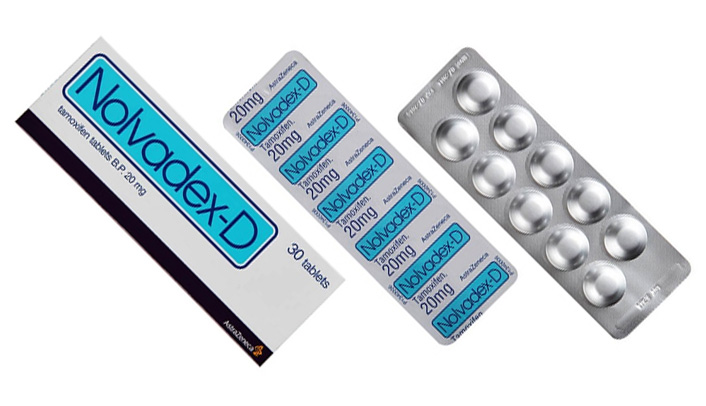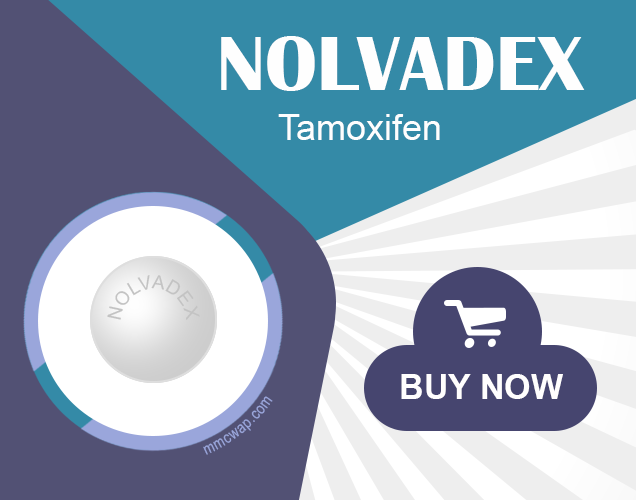Nolvadex
Nolvadex, whose generic name is Tamoxifen, is a medication primarily used in the treatment of breast cancer. It belongs to a class of drugs known as selective estrogen receptor modulators (SERMs).

Nolvadex is a non-steroidal anti-estrogen. Drug acts as an anti-estrogen by inhibiting the effects of endogenous estrogen, probably through binding to estrogen receptors.
It is recognised that Tamoxifen has estrogen-like actions on a number of body systems including endometrium, bone and blood lipids.
After oral administration, Nolvadex is rapidly absorbed and maximum serum concentrations are reached within 4-7 hours.
Sustained concentrations (approximately 300 ng/ml) are achieved after four weeks of treatment with a daily dosage of 40 mg. This drug binds well to serum albumin (>99%). Metabolism, through hydroxylation, demethylation and conjugation, results in the formation of a number of metabolites with pharmacological profile parameters similar to the parent chemical compound, thus contributing to the therapeutic effect. Excretion occurs mainly through the faeces. The elimination half-life for the drug itself has been determined to be approximately seven days, while for X-desmethyltamoxifen, the main circulating metabolite, it has been determined to be 14 days.
Composition and Dosage Form
1 film-coated tablet contains Tamoxifen (in the form of citrate) 10 or 20 mg; in a blister 10 pcs., in a cardboard box 3 blisters.
Uses
Tamoxifen is employed to treat breast cancer that has unfold to other body parts (metastatic breast cancer), to treat carcinoma in patients after surgery and radiation treatment, and to cut back the possibilities of breast cancer in unsound patients. This medication will block the expansion of breast cancer. It works by interrupting with the consequences of oestrogen within the breast tissue.
How to use Nolvadex
Usually set individually depending on the indications. Intravenously, in breast cancer, kidney - 20-40 mg 1-2 times a day (morning and evening), endometrial - 20-30 mg 1-2 times a day. For the course - 2.4-9.6 g. Treatment with Nolvadex is carried out for a long time (until the appearance of signs of disease progression), because the effect is maintained only on the background of constant use; if necessary, it is used in combination with radiation and cytostatic therapy. Tablets should be taken without chewing, drinking a small amount of liquid, in one dose in the morning or dividing the required dose into 2 doses, morning and evening.
Take this medication orally with/without food, sometimes once or two times daily for five years, or as instructed by your doctor. If you're taking the liquid, the dose should be measured carefully with a specific measuring spoon/device. The household spoon should not be used because the dose measured may not be correct. Dosage relies on your medical condition and response to medical aid. Use this medication on time to gain the foremost benefit from it. If you are suffering from breast cancer that has unfold to alternative parts of the body, you may feel elevated bone/cancer pain and/or diseases as you begin taking this drug. In some cases, this might be a signal of a decent response to the medication. These symptoms sometimes disappear quickly. Since this drug may be absorbed through the lungs and skin, pregnant ladies must not handle this drug or breathe the dust from the medication.
Side Effects
Hot flashes, muscle aches, leg cramps, nausea, hair thinning, numb/tingling skin and headache might occur. A loss of sexual interest might occur in men. If these symptoms persist or worsen, talk to your doctor promptly.
Tell your doctor directly if any unlikely however serious aftereffects occur: vision changes (e.g., blurred vision), straightforward bruising/bleeding, eye pain, mental changes, mood swings, swelling of ankles/feet, uncommon fatigue.
Contraindications
Before taking Nolvadex, tell your doctor or chemist if you're allergic to it; or if you have got the other allergies. This product might contain inactive substances, which might cause hypersensitivity or alternative issues. If you have got cancer restricted to the milk ducts, or if you're taking this medication to stop breast cancer, then this medication mustn't be used if you have got some medical conditions. Before the intake of this drug, consult your doctor or chemist if you have: a history of blood clots (e.g., pulmonary embolism, deep vein thrombosis, stroke), conditions that need treatment with warfarin (blood thinner). If you have got breast cancer and a history of blood clots or stroke, you might not be ready to take Nolvadex. Discuss the risks and advantages along with your doctor. Before using this drug, tell your doctor or chemist your case history, particularly of: high cholesterol/triglycerides, high pressure level, restricted or inability to walk (immobility), diabetes, smoking, cataracts, and liver disorder.
Pregnancy and Nolvadex
The use of Nolvadex is not recommended during pregnancy.
There are a small number of reports of spontaneous abortions, birth defects and intrauterine death in women taking Nolvadex. However, a direct causal relationship between these effects and the drug administration has not been established.
Reproductive toxicology studies in animals such as rats, rabbits and monkeys have not shown potential teratogenic effects of Nolvadex.
Observations in rodents studied for effects on fetal development and the reproductive system have shown that tamoxifen causes changes similar to those that occur with other hormones such as estradiol, ethinylestradiol, clomiphene and diethylstilbestrol (DES). Although there is no clinical association between these changes and subsequent effects in women, some of them, including vaginal adenosis, resemble changes seen in women who were exposed to DES as children and in the 1 in 1000 women who had a risk of developing vaginal or cervical clear cell cancer. However, few pregnant women have been exposed to tamoxifen, and there is no information that such exposure may be responsible for these effects in young women.
Women taking Nolvadex while sexually active are advised to use methods to prevent pregnancy, such as barrier or other non-hormonal contraceptives.
Before starting treatment in premenopausal women, it is important to perform a thorough examination to exclude the presence of pregnancy. If pregnancy occurs while taking Nolvadex or within two months after its withdrawal, it is necessary to assess the possible risk to foetal development.
There are no data on excretion of Nolvadex into breast milk in women, therefore the use of this drug during lactation is not recommended. The decision whether to discontinue breastfeeding or use of Nolvadex should be based on the importance of its use for the mother.
Additionally
A number of women taking Nolvadex for the treatment of breast cancer in the premenopausal period experience absence of menstruation.
The use of Nolvadex in combination with coumarin-type anticoagulants may cause significant enhancement of anticoagulant effect. In cases when concomitant use of these drugs occurs, it is recommended to closely monitor the patient.
When using Nolvadex in combination with cytotoxic agents, there is an increased risk of thromboembolic events.
An increased incidence of endometrial changes, including hyperplasia, polyps and cancer, has been noted in association with Nolvadex treatment. The frequency and pattern of this increase suggests that the underlying mechanism is related to the estrogenic properties of Nolvadex. All patients taking or previously taking this drug who experience abnormal vaginal bleeding should be evaluated in a timely manner.
Tamoxifen did not appear to be mutagenic in a number of in vitro and in vivo mutagenicity experiments. Tamoxifen had a genotoxic effect during some in vitro and in vivo genotoxicity experiments in rodents. During long-term studies, evidence of gonadal tumours in mice and liver tumours in rats receiving tamoxifen was established. No clinical correlation of these findings was established.
During clinical trials following treatment of breast cancer patients with tamoxifen, a number of second primary tumours arising at sites other than the enometrium and opposite breast have been noted. A cause-and-effect relationship has not been established, and the clinical significance of these observations remains unclear.
The description of the drug Nolvadex is not intended for prescribing treatment without medical advice.
Drug Images

Breast Cancer
Breast cancer is a type of cancer that forms in the cells of the breasts. It's one of the most common cancers among women worldwide, but it can also occur in men, although it's much less common.
There are different types of breast cancer that can develop in various parts of the breast. The most common types include ductal carcinoma in situ (DCIS), invasive ductal carcinoma, invasive lobular carcinoma, and less common types like inflammatory breast cancer and Paget's disease of the nipple.
Treatment options for breast cancer depend on various factors, including the type and stage of cancer, as well as the individual's overall health and preferences. Common treatments include surgery (lumpectomy or mastectomy), radiation therapy, chemotherapy, hormone therapy, targeted therapy, and immunotherapy.
DES
DES, which stands for diethylstilbestrol was a form of estrogen that doctors prescribed to women between the late 1930s and early 1970s in order to prevent miscarriages and premature births. However it was later discovered that taking DES during pregnancy posed health risks to both the women and their children.
Exposure, to DES while in the womb has been linked to health issues, including an increased likelihood of reproductive tract abnormalities types of cancers like vaginal and cervical cancers, fertility problems and other health concerns. Consequently due to its effects on health the use of DES, during pregnancy was ultimately discontinued.
Related Drugs
Arimidex
Conditions:
Breast Cancer

Estrace
Conditions:
Breast Cancer




